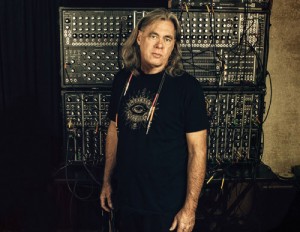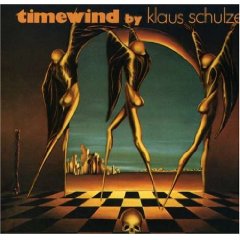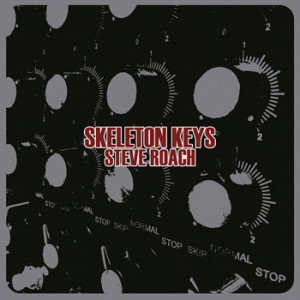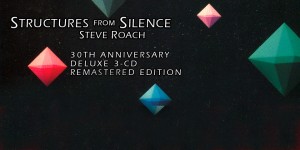Steve Roach Unlocks Doors with Skeleton Keys
Podcast: Play in new window | Download
Subscribe: RSS
Hear the Steve Roach interview above or download it from iTunes.
 Steve Roach has been an icon of Echoes for as long as there has been Echoes. Not only did he write our original theme music in 1989, just last year Roach was awarded the title of the number one Icon of Echoes. He came to renown in the 1980s for seminal albums like Structures from Silence, Dreamtime Return and Empetus. After moving through techno tribal and drone zone music, Roach has returned to his analog sequencer roots for the album, Skeleton Keys, working with an old style modular synthesizer system that he constructed. It was an Echoes CD of the Month in May. We spoke with Roach from his studio outside of Tucson, Arizona.
Steve Roach has been an icon of Echoes for as long as there has been Echoes. Not only did he write our original theme music in 1989, just last year Roach was awarded the title of the number one Icon of Echoes. He came to renown in the 1980s for seminal albums like Structures from Silence, Dreamtime Return and Empetus. After moving through techno tribal and drone zone music, Roach has returned to his analog sequencer roots for the album, Skeleton Keys, working with an old style modular synthesizer system that he constructed. It was an Echoes CD of the Month in May. We spoke with Roach from his studio outside of Tucson, Arizona.
Steve Roach unlocks the door of Skeleton Keys with a track called “The Only Way In.” It opens, by going backwards.
“That was a technique that I created where I took that, actual piece and did a reverse technique on it” explains Roach. “And then brought it back out of itself, so where it feels like you’re being sucked backwards in time,” “It really is that, playing as a metaphor with that idea that you’re, blending and working with the inspirations from years ago, and infusing it into now.”
On Steve Roach’s Skeleton Keys, the acclaimed electronic musician revisits a sound that was sequencer driven and analog synthesizer generated. That’s what inspired him to enter music in the first place. In the 1980s, the covers of Tangerine Dream’s Rubycon and Klaus Schulze’s Timewind hung on his wall the way some people mount crucifixes.
 “Rubycon and Timewind, those were the two columns that were holding up the universe of this at that time.” Roach reminisces. “At that time I had this epiphany around the music that it was circular music and that it was like a mandala that made music; I had that visual so strong. I mean, this was listening to it in a non-enhanced state of mind as well. So there were those kinds of touchstones that I would do and I continue to feel connected to, since Dreamtime, the last 25 years.”
“Rubycon and Timewind, those were the two columns that were holding up the universe of this at that time.” Roach reminisces. “At that time I had this epiphany around the music that it was circular music and that it was like a mandala that made music; I had that visual so strong. I mean, this was listening to it in a non-enhanced state of mind as well. So there were those kinds of touchstones that I would do and I continue to feel connected to, since Dreamtime, the last 25 years.”
For Skeleton Keys, Roach came directly back to that sound. It seems as if he was following the spirit of T.S. Eliot in “Little Gidding.” Like T.S. Eliot’s life journey Roach has returned to the beginning and seen it anew.
“I don’t feel like I’m at the end of the exploring, but I’m kind of coming full circle,” agrees Roach. “And it’s in terms of like a spiral circling back around to kind of a beginning point or reference point of an earlier time, but with all that’s happened over, you know, 30-something years to inject into where I’m at now.”
Which is to say, Roach hasn’t just gone back to the sound of his 1986 sequencer masterpiece, Empetus. Instead, Skeleton Keys is informed by everything in between that beginning with Dreamtime Return in 1989 and continuing through techno tribal, drone zone, ambient Americana and adventures into the abyss.
 With Skeleton Keys Steve Roach goes back to analog electronics in a big way. Over the last few years he’s been assembling a massive, wall sized synthesizer based around the old Moog modular systems that looked like telephone switchboards with patch bays, knobs and switches. And there is no keyboard.
With Skeleton Keys Steve Roach goes back to analog electronics in a big way. Over the last few years he’s been assembling a massive, wall sized synthesizer based around the old Moog modular systems that looked like telephone switchboards with patch bays, knobs and switches. And there is no keyboard.
“There’s no keyboard at all,” he insists. “The entire album and all the interlocking parts are all created from the way you carve out these patterns, and sequences and rhythms with hands on. So it really does have this feeling of shaping it, you know, like you’re carving something out using both hands on a large variety of knobs, on filters, envelopes and the essentials, of the components that makes up the analog modular the way I designed it for this style of music.”
After 35 years of recording, Steve Roach now has the kind of tools that his early heroes employed, only more stable. Central to the sound are his sequencers, devices that play repeating patterns of notes.
“Some of the sequencers are still designed off the early Moog sequencer that was used by Klaus and Tangerine Dream, the very exact sequencer,” Roach enthuses.
“So that in itself would be like a guitarist getting hold of an early Strat or a Gibson SG or something, and having been inspired by guitarists that used that. There’s a certain thing that just happens when you put your hands on those instruments.”
Roach recorded Skeleton Keys in real time, programming, manipulating and layering sequences, while he altered timbres, filters and envelopes. He’s like a cosmic juggler keeping concentric circles of sound spinning in interlocked patterns.
 “It’s created as you’re hearing it,” he says, striving to make clear that there aren’t computer programs or multi-track layering driving the show. “I mean there’s a completely live interactive organic occurrence that’s happening and I’m recording it as you’re hearing it, so that’s part of the energy that that music holds is that you’re not laying a track down and then syncing it back up, and coming back, and laying another track down, and wondering if that worked there’s none of that going on. It’s just completely instinctive, intuitive, let it rip.”
“It’s created as you’re hearing it,” he says, striving to make clear that there aren’t computer programs or multi-track layering driving the show. “I mean there’s a completely live interactive organic occurrence that’s happening and I’m recording it as you’re hearing it, so that’s part of the energy that that music holds is that you’re not laying a track down and then syncing it back up, and coming back, and laying another track down, and wondering if that worked there’s none of that going on. It’s just completely instinctive, intuitive, let it rip.”
There are no chord sequences, drum machines or ambient pads on the album. It’s all dancing melodic lines, building, evolving, interacting and deconstructing.
“It’s really like clock music. You’re just taking patterns that are interlocking inside of other patterns,” he clarifies. “So it’s really like mandala music where concentric rings affect each other.”
There’s one other thing that’s different about this music for Steve Roach.
“I’m also standing up,” he bursts out. “I mean the whole feeling of playing this music is you’re moving around a lot. You’re not sitting in a chair and you’re not sort of pondering things. It’s body music too.”
Skeleton Keys is one of Roach’s most energized albums, but we still recommend listening to it laying down, volume loud, spiraling into Roach’s overlapping concentric spirals. Skeleton Keys is out on Projekt Records and he’s also released a companion prequel album, The Skeleton Collection 2005-2015 out on Timeroom Editions.
~John Diliberto
